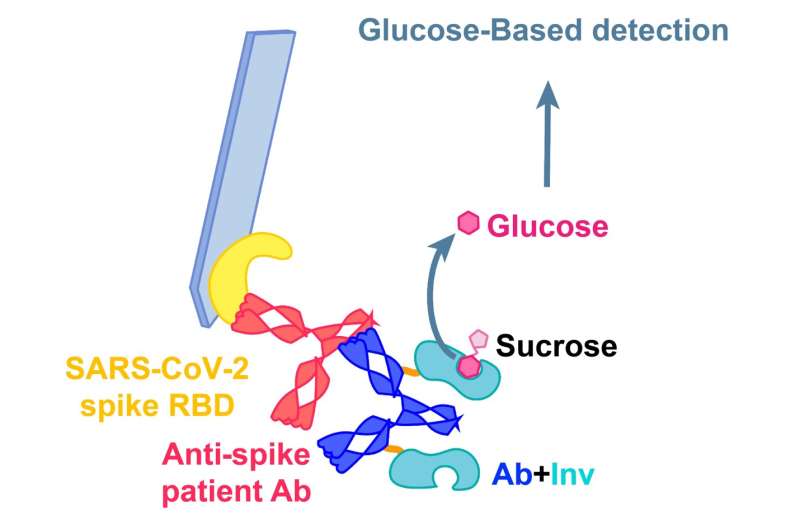With this reaction, a glucose meter can detect SARS-CoV-2 antibodies in patient samples. (Ab=antibody; Inv=invertase). Credit: Adapted from Journal of the American Chemical Society 2022, DOI: 10.1021/jacs.2c02537
Over-the-counter COVID tests can quickly show whether you are infected with SARS-CoV-2. But if you have a positive result, there's no equivalent at-home test to assess how long you're protected against reinfection. In the Journal of the American Chemical Society, researchers now report a simple, accurate glucose-meter-based test incorporating a novel fusion protein. The researchers say that consumers could someday use this assay to monitor their own SARS-CoV-2 antibody levels.
Vaccines against SARS-CoV-2 and infection with the virus itself can guard against future infections for a while, but it's unclear exactly how long that protection lasts. A good indication of immune protection is a person's level of SARS-CoV-2 antibodies, but the gold standard measurement—the enzyme-linked immunosorbent assay (ELISA)—requires expensive equipment and specialized technicians.
Enter glucose meters, which are readily available, easy to use and can be integrated with remote clinical services. Researchers have been adapting these devices to sense other target molecules, coupling detection with glucose production. For example, if a detection antibody in the test binds to an antibody in a patient's blood, then a reaction occurs that produces glucose—something the device detects very well. Invertase is an attractive enzyme for this type of analysis because it converts sucrose into glucose, but it's difficult to attach the enzyme to detection antibodies with chemical approaches. So, Netzahualcóyotl Arroyo-Currás, Jamie B. Spangler and colleagues wanted to see whether producing a fusion protein consisting of both invertase and a detection antibody would work in an assay that would allow SARS-CoV-2 antibody levels to be read with a glucose meter.
The researchers designed and produced a novel fusion protein containing both invertase and a mouse antibody that binds to human immunoglobulin (IgG) antibodies. They showed that the fusion protein bound to human IgGs and successfully produced glucose from sucrose. Next, the team made test strips with the SARS-CoV-2 spike protein on them. When dipped in COVID-19 patient samples, the patients' SARS-CoV-2 antibodies bound to the spike protein. Adding the invertase/IgG fusion protein and then sucrose led to the production of glucose, which could be detected by a glucose meter. They validated the test by performing the analysis with glucose meters on a variety of patient samples, and found that the new assay worked as well as four different ELISAs. The researchers say that the method can also be adapted to test for SARS-CoV-2 variants and other infectious diseases.
More information: Elissa K. Leonard et al, Antibody–Invertase Fusion Protein Enables Quantitative Detection of SARS-CoV-2 Antibodies Using Widely Available Glucometers, Journal of the American Chemical Society (2022). DOI: 10.1021/jacs.2c02537
Journal information: Journal of the American Chemical Society
Provided by American Chemical Society
























